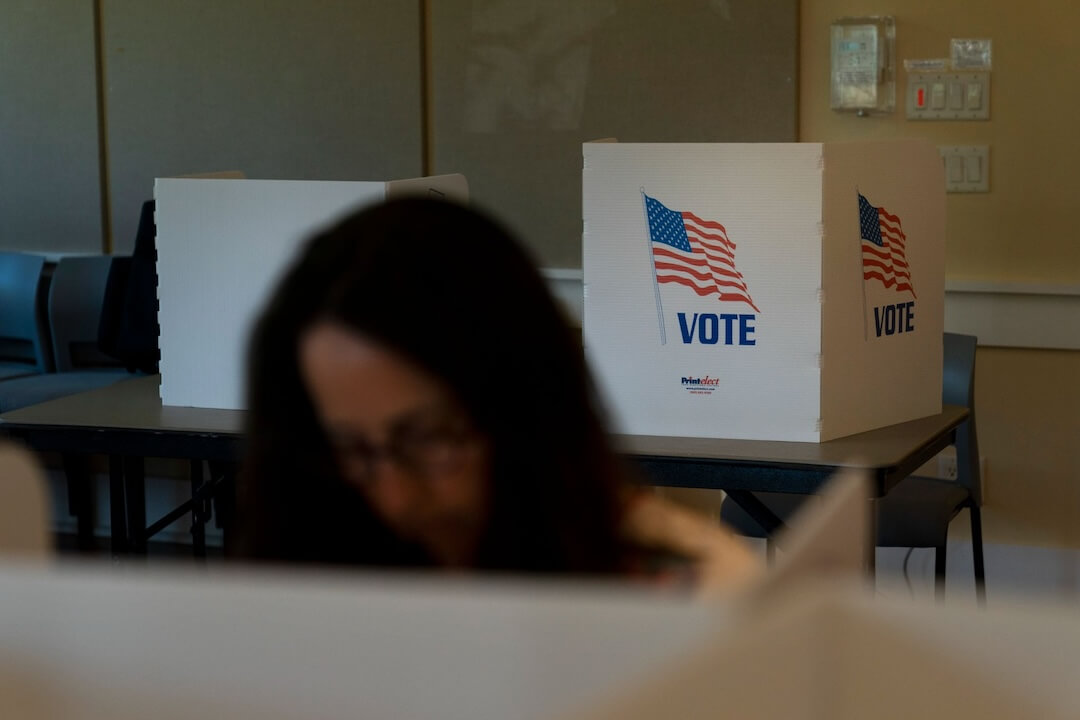As managing editor, I oversee Poynter’s coverage of all media-related topics. That includes the business of media, where it feels like layoffs, closures and all sorts of downsizings tell the story of any given day.
Given the state of affairs, and perhaps informed by the fact that I graduated from college during the Great Recession, it’s easy to see a pessimistic future for the biz. I feel a certain kinship with climate reporters; another area where good news often feels in short supply.
Still, as any decent journalist should do, I love to consider alternative viewpoints. Are things as bad as they seem? I asked Angela Fu, Poynter’s media business reporter, and Rick Edmonds, Poynter’s media business analyst, to sit down with me to reflect on the past month.
Ren LaForme: Recognizing we’re only a month in, what’s the deal with 2024? We’ve seen layoffs, big changes or closures at the Los Angeles Times, Business Insider, Condé Nast, National Geographic, NBC News and The Messenger. I’m probably missing a bunch. It seems like everyone keeps citing “economic headwinds.” What’s going on?
Angela Fu: None of the problems that plagued 2023 — which also saw mass layoffs and closures — have magically disappeared. Outlets are still struggling with declining audiences, a weak advertising market, inadequate revenue models, and so forth. I view January 2024 as a continuation of 2023. It’s also still “layoff season,” so companies are making cuts as they try to get their 2024 budgets in shape.
Rick Edmonds: I’ve been asked (by our boss, Poynter president Neil Brown) what these “economic headwinds” are that we hear so much about. Just advertising, or something else? Angela nails it — overoptimistic estimates of ad and digital circulation revenue are the heart of the problem. But consider a couple more. For those outlets still with print products, distribution costs are a killer — whether throwing papers in your driveway or shipping magazines through the mail.
Another trend we all know about continues apace — the fragmentation of audiences. Boy, did the short life of The Messenger show the market does not need another broad general news site, however well funded. Established outlets too grope for a product mix that reaches the biggest swath of users.
LaForme: It sounds like what’s happening is that those “economic headwinds” are exacerbating flaws that already existed. Perhaps the latest waves of layoffs felt so stark because we weren’t maybe aware of those flaws? I’m thinking about how shocking it was that The Texas Tribune, always a bright spot in the industry, held its first-ever layoffs in its 14-year-history in August. And how the Los Angeles Times, which has a billionaire owner, laid off 115 just a few weeks ago.
Edmonds: Yes and yes. The “headwinds” are real, in my opinion. But that also remains a vague euphemism in place of more open discussion of the specific problems like costs, audience, etc., and how the organization is trying to fix them.
Fu: I think that’s right. I think another reason the layoffs feel unexpected is because there was a lull in cuts in some parts of the industry during 2021 and 2022. Some places hired aggressively during those years. Even entering 2023, some news leaders were overambitious with their budgets — and later paid for their mistakes with cuts.
LaForme: The headlines are stark. The Atlantic: “Is American Journalism Headed Toward an ‘Extinction-Level Event’?” The New York Times: “The News About the News Business Is Getting Grimmer.” Our own site: “Tuesday was a bleak day for the media industry.” Are things really as dire as the headlines make it seem?
Edmonds: You tee up a favorite answer of mine to a question I have been asked many times. Decline and death are not the same thing, though admittedly, the one sometimes leads to the other. In particular, I have repeatedly heard predictions about the imminent death of local newspapers in the 20 years I have been doing this work. Hasn’t happened, except in the smaller markets Penny Abernathy has chronicled so well.
What is disturbing this time is how slim local reports have grown at the mid-sized outlets of Alden, Gannett, Lee and many others. We do seem to be speeding toward the vicious cycle my mentor, the late Phil Meyer, called a death spiral — bad revenues lead to cuts, lead to a worse product, lead to less appeal to audiences and advertisers. Then that repeats.
Fu: To answer the question, yes … and no. Things are undeniably bad, and it’s hard to imagine a sudden reversal in a trend that is decades in the making. I think that’s why some journalists are exploring more “structural” solutions like legislation to make tech companies pay for the news stories shared on their platforms, or tax subsidies to incentivize investment in journalism. As Rick points out, a lot of local legacy papers (especially those owned by chains) have dwindled considerably and show no signs of stopping.
At the same time, there are still some outlets, local and national, that seem to have found a strategy that works for them. Places like The Boston Globe and The New York Times are still turning a profit.
LaForme: Angela, you’ve reported on the massive unionization trend over the past few years. What has the labor response been like to these types of developments?
Fu: There have been a lot more walkouts and one-day strikes, driven in part by cuts. The Los Angeles Times Guild’s one-day strike is a massive example. Nearly 90% of the union walked out a day after learning that layoffs were coming. (Most work stoppages take weeks, if not months, to plan.)
Unions generally can’t prevent layoffs or closures, but they can soften the effects. They can negotiate into their contracts policies like better severance packages, layoff moratoriums, buyout procedures to reduce layoffs, and successorship agreements to protect their contracts in the event of a sale.
Some newsrooms have also tried to unionize to take advantage of “status quo” protections under federal labor law. The law prevents companies from unilaterally changing working conditions for unionized employees who don’t have contracts. When Gannett did its mass layoffs a couple years ago, a lot of newly unionized journalists were spared because they were still negotiating their first contracts.
LaForme: Are there any parts of the news media world that are better positioned? Broadcast news typically sees a pretty big advertising windfall during election years. Can we still expect that?
Edmonds: This will be a good year with political advertising boosting local broadcast — selectively in battleground states, not everywhere. It’s to be determined how big. However, I am hearing that the bump may be less than in previous cycles as candidates’ budgets continue to shift to targeted digital alternatives.
LaForme: Are either of you keeping a close eye on any specific news organizations? Maybe a bright spot? Or an outlet you’re expecting a lot of change from? A harbinger?
Edmonds: I’m looking for the next Texas Tribune, Chalkbeat or Report for America. Something that can grow big we haven’t even thought of yet. And an editor with a strong vision and a ton of drive to pull it off.
Fu: Making predictions feels risky, especially after some of last year’s more unexpected layoffs and closures. I’m interested in seeing how historically strong newsrooms that had cuts last year, like The Washington Post and The Texas Tribune, fare this year. I’m also interested in seeing whether the buzzy nonprofit startups that some point to as the future of journalism can find a sustainable path forward.
LaForme: These sorts of changes are often reported through a cold, hard business lens. But I want to close with advice for the journalists — and business side people, production staff and more — who are facing cuts. Do you have any thoughts you’ve learned from covering many, many layoffs that you could share with media workers who might be keeping a wary eye or two on the industry news?
Fu: You’re definitely right that these cuts extend beyond those traditionally thought of as journalists. Several printing plants are set to close this year, which could worsen the reader experience if out-of-date news is printed due to earlier deadlines. On the labor front, I’ve noticed that several recent union campaigns have been “wall-to-wall,” meaning that editorial and business employees are organizing together instead of forming separate units.
For media workers, I think the sudden closure of The Messenger and CNN Philippines’ websites this week serve as a reminder that all journalists should be regularly saving their work. And for those laid off, there are online resources available from job boards to community aid networks that were created specifically to help journalists.
Edmonds: True. Cuts reach through the organization; sometimes management will claim that the newsroom is less hard hit. Impacts vary. Some business and digital skills are very portable. On the other hand, when a print plant closes, press operators will have a hard time finding any demand for their kind of work. News organizations don’t need nearly as many ad sales persons as they did in better times, so they need to be ready for some career shifts, too.
For journalists, I would suggest first taking time to absorb the shock. Then at least take a look at how valuable your skills of finding information and writing up the findings clearly are to a range of interesting employers.
That’s what I did when I was fired in 1992 and spent a fascinating eight-year sabbatical working for the governor on Florida education policy (in a much more hospitable climate than now). After a while though, I got the bug again, came back to journalism at Poynter and have been happy professionally ever since.
By Ren LaForme, Poynter managing editor
Lee Enterprises reports 46% of revenue last quarter came from digital
Digital revenue made up 46% of Lee Enterprises’ total operating revenue last quarter, the company announced Thursday. It expects digital revenue to exceed print by the second half of 2024.
Fueling that growth in digital revenue has been an expanding subscriber base, Lee executives said on an earnings call Thursday. The company noted that it has found success in both adding digital subscribers and retaining them even through price increases. Lee, which operates more than 70 daily newspapers, is trying to shape its business model so that it can sustain itself on digital revenue and not rely on print, which has been on the decline.
“The long-term results of our strategy are expected to generate more than $450 million of recurring sustainable digital revenue within five years,” CEO Kevin Mowbray said. “With that level of performance, we will be sustainable solely through cash flow generation from our digital products.”
Though Lee ended its first quarter of 2024 with a $1 million profit, its total operating revenue fell nearly 16% year-over-year to $156 million. Expenses also fell, in part due to cost-cutting measures taken last year, including layoffs and the elimination of print days. Lee still owes $454 million in debt from its 2020 acquisition of Berkshire Hathaway’s newspapers.
In response to an investor’s question, Lee executives said they expect to receive $4 to $5 million in political advertising spending over the next year.
“We operate in some key states, including Montana, where there’ll be a lot of money spent in, and in other areas like North Carolina and Wisconsin,” CFO Timothy Millage said.
Lee stock closed at $9.62 a share Thursday, down more than 11% from the previous day’s close.
By Angela Fu, media business reporter
Good work out of Minnesota
U.S. Rep. Ilhan Omar (D-Minn.) spoke at an event about a recent election in Somalia on Saturday and sparked criticism from conservative media and politicians. That’s not unusual. Omar, who was born in Somalia and is one of a handful of female Muslim elected officials in Congress, is frequently a topic du jour among conservative critics.
But this time was different. The words she was being criticized for saying? They were mistranslated.
Good, then, that The Star Tribune and the Minnesota Reformer both worked to verify the accuracy of the translations and set the record straight.
The Star Tribune had a reporter who speaks Somali listen to the speech and review an official transcript provided by Omar’s team. The Reformer, part of the nonprofit States Newsroom network, obtained two independent translations of Omar’s speech, including one by a federally certified court interpreter.
Both news organizations found that the characterization of her comments — about Somali identity and the United States’ role in intervening in the region — was inaccurate.
This is the layer of fact-checking that news organizations have always excelled at providing. As media critics ponder an America without a robust news ecosystem (already a reality in many locations), I shudder to imagine the sorts of fact-light viral stories that are waiting in the wings.
By Ren LaForme, managing editor
Media tidbits and links for your weekend review
- Jordan Hoffman was a senior writer and critic at The Messenger, the high-profile media outlet that shut down Wednesday and laid off its entire staff of 300 after publishing for less than a year. For New York Magazine, Hoffman writes, “Killing The Messenger: My Final Days Working at a Disaster.”
- Jimmy Finkelstein, founder of The Messenger, reportedly sought out buyers in a last-ditch effort to keep the publication afloat. The Hollywood Reporter’s Lachlan Cartwright writes that Los Angeles Times owner Dr. Patrick Soon-Shiong was one of those potential buyers. Cartwright reports that Soon-Shiong offered a “low ball” figure for The Messenger on Tuesday, just days after announcing 115 layoffs at the Los Angeles Times. By Wednesday, the deal had fallen through.
- Journalists at The Messenger produced some notable reports in the nine months the site was online. Best of luck looking back on them, though. The Messenger website now displays only a logo and email address. Good thing the Internet Archive’s Wayback Machine exists.
- What’s happening at Sports Illustrated? First, a bizarre licensing dispute that may (or may not?) result in the layoffs of its entire staff. Then, accusations of union-busting. Now this: The Washington Post’s Ben Strauss reports that SI’s publisher called for the removal of a story about transgender boxing from an upcoming issue of the print magazine.
- For CNN, Curt Devine, Donie O’Sullivan and Sean Lyngaas write, “A fake recording of a candidate saying he’d rigged the election went viral. Experts say it’s only the beginning.”
- Meteorologists, climate scientists and public officials once looked to the skies to alert people to upcoming weather events. Now, they are increasingly fighting against misinformation on the internet. For The New York Times, Shawn Hubler writes, “When the Storm Online Is Worse Than the One Outside.”
- Associated Press media writer David Bauder writes, “Inside Donald Trump’s curious relationship with Fox News — and what it means for other candidates.”
- “She spent years making everyone feel like her best friend. He spent years refining a wide-open approach to celebrity. Now fans must grapple with the urge for juicy details.” The Washington Post’s Emily Yahr with, “Taylor and Travis — and everything you’re dying to know!”
- In a guest column for The New York Times, author and New York University professor Eric Klinenberg writes, “We Were Wrong About What Happened to America in 2020.”
- From PolitiFact’s Grace Abels, Louis Jacobson, Renee Romo and Amy Sherman: “What PolitiFact learned in 1,000 fact-checks of Donald Trump.”
- The Hill’s Dominick Mastrangelo writes about the NewsNation anchor: “Chris Cuomo calls Taylor Swift ‘crazy sauce’ conspiracy theories a ‘mashup of madness.’”
- NBC late-night host Seth Meyers delivers this somewhat humorous, somewhat serious six-minute monologue on the troubles facing newspapers and websites, such as The Los Angeles Times and Sports Illustrated.
More resources for journalists
- The 2024 Poynter Journalism Prizes are now open for entries. To enter, go to the contest website. The deadline for entries is Feb. 16.
- Delve more deeply into your editing skills with Poynter ACES Intermediate Certificate in Editing. Start anytime.
- Essential Skills for Rising Newsroom Leaders (Seminar) (May) — Apply by March 26.
- Lead With Influence (Seminar) (June) — Apply by May 6.
Have feedback or a tip? Email Poynter senior media writer Tom Jones at tjones@poynter.org.
The Poynter Report is our daily media newsletter. To have it delivered to your inbox Monday-Friday, sign up here.










Too many news organization doing pretty much the same thing. It’s why ANY business with too many undifferentiated competitors cannot find enough pieces of the pie, even if they attempt to expand the pie. Add to that, political news is so depressing that news audiences are actually shrinking.